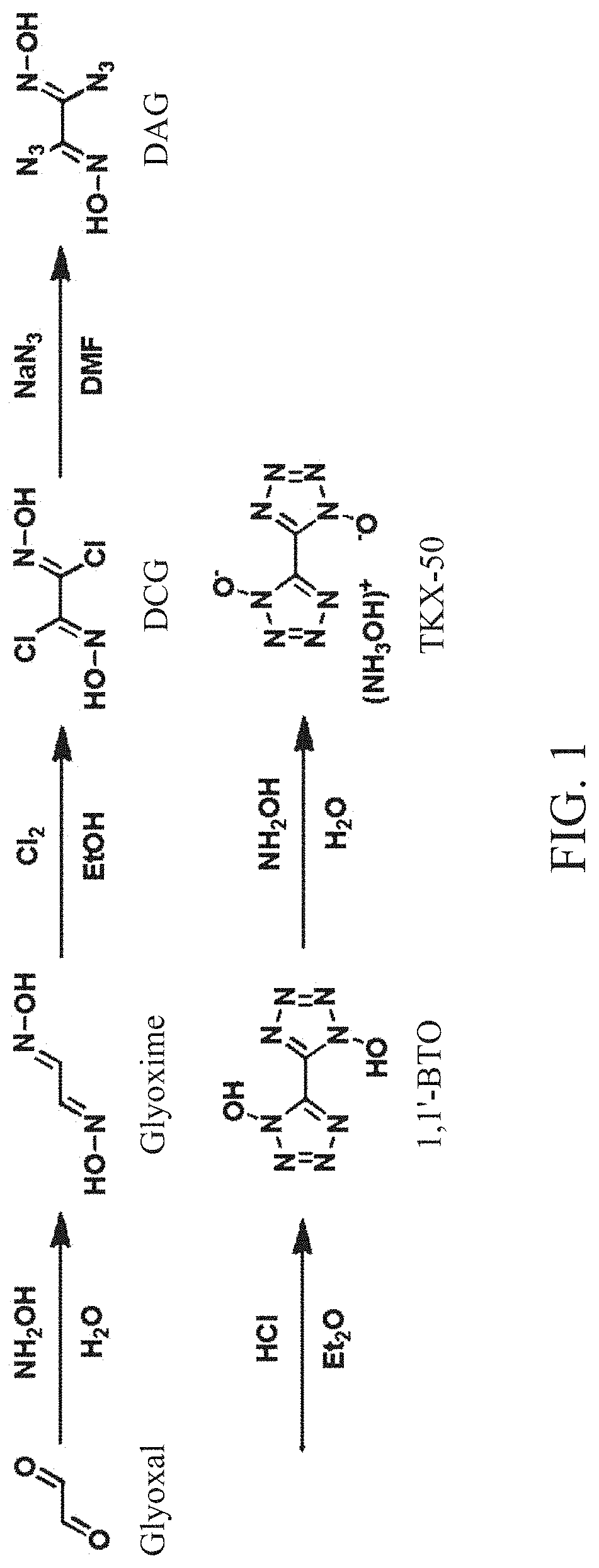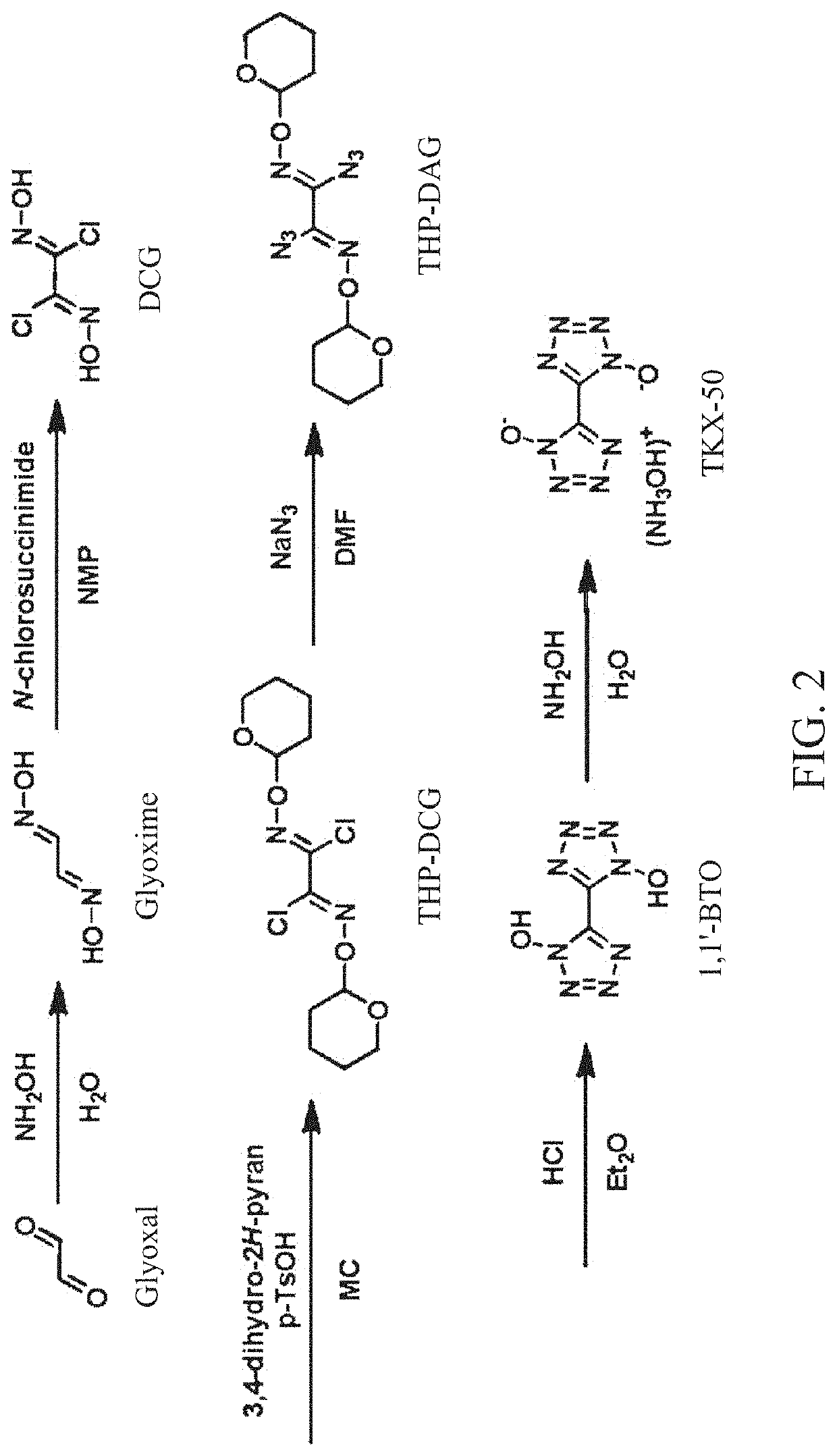Method for synthesis of TKX-50 using insensitive intermediate
a technology of insensitive intermediate and synthesis method, which is applied in the direction of explosives, weapons, organic chemistry, etc., can solve the problems of threatening the safety of the operator, the danger of an accident, and the drawback of a person handling ddf and onc, so as to achieve the effect of safe work
- Summary
- Abstract
- Description
- Claims
- Application Information
AI Technical Summary
Benefits of technology
Problems solved by technology
Method used
Image
Examples
example 1
of Glyoxime
[0067]18.4 g (0.46 mol) of NaOH and 50 mL of distilled water were added to a reactor, cooled to 0° C., and 46 g (0.66 mol) of hydroxylammonium chloride was added to the reactor. Subsequently, 47.9 g (0.33 mol) of 40% glyoxal aqueous solution was added to the reactor while maintaining a temperature of 0 to 10° C. When a solid is produced after stirring for 1 hour while maintaining an internal temperature of the reactor at 0° C., filtration, and washing with a small amount of ice water were performed. Subsequently, drying was performed to obtain 24.7 g (0.28 mol, 85%) of glyoxime.
example 2
of DCG Through Glyoxime
[0068]18 g (0.20 mol) of glyoxime and 180 mL of DMF were added to the reactor, cooled to 0° C., and 54.5 g (0.40 mol) of N-chlorosuccinimide was slowly added to the reactor. Subsequently, stirring was performed for 30 minutes while maintaining the internal temperature of the reactor at 0° C., the internal temperature was slowly raised to 25° C., and stirring was performed for 1 hour. Subsequently, after 200 mL of distilled water was added, a reaction solution was transferred to a separatory funnel and extraction was performed with 200 mL of EA and 150 mL of distilled water three times. After evaporating the obtained organic layer under reduced pressure, crude DCG was obtained. The obtained crude DCG and 100 mL of MC were added to the reactor and stirred at room temperature for 1 hour, followed by filtration. Subsequently, drying was performed to obtain 25.4 g (0.16 mol, 81%) of DCG.
example 3
of THP-DCG Through DCG
[0069]10 g (63.7 mmol) of DCG, 300 mL of MC, 36.7 g (191.4 mmol) of p-TsOH and 16.1 g (191.4 mmol) of 3,4-dihydro-2H-pyran were added to the reactor and stirred at room temperature for 2 hours. Subsequently, after 300 mL of distilled water was added, a reaction solution was transferred to a separatory funnel and extraction was performed with 200 mL of MC and distilled water of 200 mL three times. Subsequently, MC was evaporated under reduced pressure and purified by a column chromatography to obtain 14.9 g (45.9 mmol, 72%) of THP-DCG.
PUM
| Property | Measurement | Unit |
|---|---|---|
| weight ratio | aaaaa | aaaaa |
| temperature | aaaaa | aaaaa |
| weight ratio | aaaaa | aaaaa |
Abstract
Description
Claims
Application Information
 Login to View More
Login to View More - R&D
- Intellectual Property
- Life Sciences
- Materials
- Tech Scout
- Unparalleled Data Quality
- Higher Quality Content
- 60% Fewer Hallucinations
Browse by: Latest US Patents, China's latest patents, Technical Efficacy Thesaurus, Application Domain, Technology Topic, Popular Technical Reports.
© 2025 PatSnap. All rights reserved.Legal|Privacy policy|Modern Slavery Act Transparency Statement|Sitemap|About US| Contact US: help@patsnap.com



